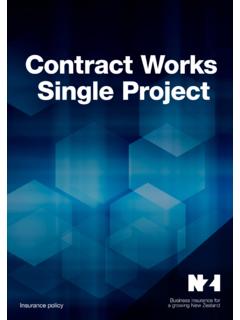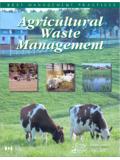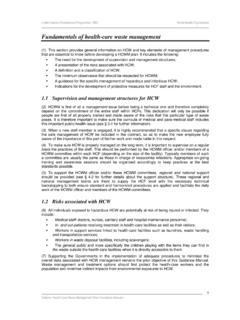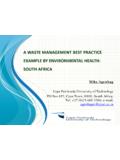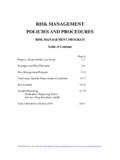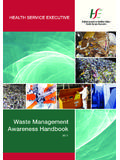Transcription of Warehousing risk management guide - NZI
1 NZI Risk SolutionsTMHelping our customers stay in business by reducing riskWarehousing risk management guideAbout NZI Risk SolutionsNZI has extensive experience in providing expert risk management advice to help our commercial customers remain in business. We have used this industry knowledge to develop a series of guides covering a range of risk management issues to help you take control of your 2 Addressing business risk 3 Developing a business continuity plan 19 Self-assessment risk management checklist 20 Many business owners are unaware of the numerous risks within their business and the effect these could have on their ability to continue trading. The real cost of a major loss incident is not only the direct loss or damage, but also the time spent dealing with the aftermath including disruption to work and production schedules.
2 Customer loyalty and business reputation can also be adversely business risk management guideRisk management is critical to business survival Risk management is critical to business survival. At NZI we want to share our risk management expertise with our business customers and, in particular, help them to address those risks associated with their buildings and the owner of a Warehousing business, what are some of the risks I need to be aware of ?The key risks for Warehousing are fire, flooding and security. In terms of fire, it s not only the product that s at risk, but also the packaging materials, storage systems and building materials that add to the fire load. Hot work ( welding or angle grinding) undertaken in a warehouse situation is also a fire risk. Other important risk areas include: worker safety, material storage, the use of equipment like forklifts, electrical safety, and the storage of flammable and environmentally hazardous substances.
3 It s also important to have good risk management programmes in place to control risk related to general housekeeping, waste management and health and safety. First things first check your insurance policy and endorsementsWhen starting on your risk management journey, it s important to check your insurance policy and any endorsements that are applicable to it. Your policy and endorsements set out exactly what your insurer will pay for as a result of accidental loss, and what you are not insured for. It is particularly important that you understand any exclusions that may apply to your insurance policy. Having the right cover and adequate sum(s) insured is critical to your business surviving a significant you have any questions it s important that you discuss these with your Insurance Risk Solutions 2 Warehousing risk management guide Fire safetyFire represents a significant risk for any business, but particularly warehouses, which are usually large spaces packed high with goods making them conducive to fire spread.
4 The reality is that the only proven method of controlling a warehouse fire is with a properly designed and maintained automatic sprinkler system. However, it s important to have hand-operated fire extinguishers available as key elements of a well-planned fire protection system are outlined extinguishers and hose reelsBest practice for business premises is the installation of hand-operated fire extinguishers and/or hose reels. Accidental fires are more likely to occur during working hours due to the greater use of electrical equipment, heating and normal extinguishers should be installed by approved contractors and mounted on brackets with clear signage indicating their positions so they can be easily located in an emergency. They require annual servicing by approved contractors to ensure they remain ready for use and they should also be checked regularly by staff on Zealand StandardsNZS 4503:2005 Hand operated fire-fighting equipment, is the minimum standard for hand-operated fire fighting equipment in New Zealand.
5 The other relevant Standard is NZS 1850:2009 Portable fire extinguishers Classification, rating and performance testing. It classifies and rates fire extinguishers to determine the appropriate type of extinguisher by fire type chemical fire or electrical fire etc. You should ensure that your fire extinguishers are selected, installed and maintained in accordance with these the correct fire extinguisherCare should be taken to use the right type of fire extinguisher. Using the wrong fire extinguisher on certain fires can sometimes have disastrous results never use water extinguishers on burning liquids or oils or electrical sprinkler systems and automatic fire detection systemsSprinkler systems have become the most widely used and most reliable automatic means of fire sprinkler systems automatically detect a fire, transmit an alarm to the Fire Service as a result of water flow and control or extinguish the fire.
6 Sprinklers provide 24/7 fire protection as needed in the immediate vicinity of the business risk what to be aware ofThe following pages include information about the most common areas of risk associated with Warehousing as well as more general risks all businesses should be aware of. NZI Risk Solutions 3 Warehousing risk management guide Automatic fire sprinklers provide significant protection for the occupants of a building, as well as the environment, by minimising the effects that a major structural fire could have. Only the sprinkler heads within the vicinity of a fire will activate all the sprinkler heads do not go off at once. If your building is fitted with either a fire sprinkler system or a fire detection system, these should be maintained regularly by an approved warrant of fitnessThe Building Act 2004 requires owners of buildings with specified systems (such as sprinklers, lifts and fire alarms) to provide the relevant council with an annual building warrant of fitness (WOF).
7 The WOF confirms that the building s specified systems are being maintained and are operating effectively, and must be publicly displayed. Fire doors and smoke control doorsIf your building has automatic self-closing fire doors or smoke control doors it is important that these are kept clear of any obstructions. We also suggest you arrange for regular monthly operating checks (possibly by the building owner) and annual inspection or maintenance to be undertaken and documented by a skilled fire protection fire drillsAn orderly and efficient response to an emergency can be vital to the protection of property and the safety of people. It is strongly recommended that regular fire drills are held so that employees, volunteers and other regular visitors are aware of the procedure should an evacuation become fire drills will also help determine problems or danger areas, equipment problems or failures, knowledge of likely evacuation times and external meeting areas.
8 Evacuation plans should then be posted internally for each building and, wherever possible, drills should be conducted with the knowledge and support of your local fire procedureIn the event of an emergency, the speed with which people can safely exit the building can mean the difference between life and death and therefore the internal layout of your building(s) should allow for adequate means of is recommended that fire exits, doors relating to fire exits and paths of travel to fire exits, be routinely checked to ensure they are not obstructed or impeded in anyway. The final exit doors should be suitably signed and checking of fire exits should form part of your regular hazard inspection regime. To assist with safe evacuation, notices providing clear instruction on how to evacuate and raise the alarm should be displayed at the main exit doors.
9 It is strongly recommended that regular fire drills are held so that employees, volunteers and other regular visitors are aware of the procedure should an evacuation become necessary. NZI Risk Solutions 4 Warehousing risk management guide Hot work fire safetyThere are a number of risk factors associated with hot work, including a high risk of work includes: welding, flame cutting, disc cutting, grinding, blow lamps, brazing, burning off, soldering and the use of hot air guns. We ve outlined a few key steps you can take to help prevent this type of fire on your work permitBefore carrying out any hot work on site, a Hot Work Permit should be issued. The person authorised to issue a permit ( warehouse manager) should inspect the work area prior to releasing the permit and confirm all precautions have been taken in accordance with the New Zealand Standard 4781:1973 Code of Practice for Safety in Welding and recommend using the NZI Hot Work Permit Card , which is freely available from our Surveyors.
10 This will help to easily identify fire hazards and take the necessary hot work hazardsHere are a few key steps you can take to ensure you manage hot work fire safety effectively on your premises.``Where possible, move the hot work object to a designated safe location, such as a welding bay.``If the hot work object cannot be moved, relocate all movable fire hazards to a safe place.``If the hot work object cannot be moved and if all fire hazards cannot be relocated, provide guards to confine the heat, sparks and slag, and protect the immovable fire hazards.``Establish a Fire Watch Duty and assign people key responsibilities for overseeing the hot work. Where possible, a fire hose should be available to use, if required.``To eliminate the risk of fire, conduct a final check for hot spots 30 minutes after hot work is completed.``For more detailed fire safety guidelines refer to the NZS 4781:1973 Code of Practice for Safety in Welding and Cutting, Part work precautionsThe following factors must be considered before a hot work permit can be issued:``Ensure hand-operated fire extinguishers or hose reels are readily available.


